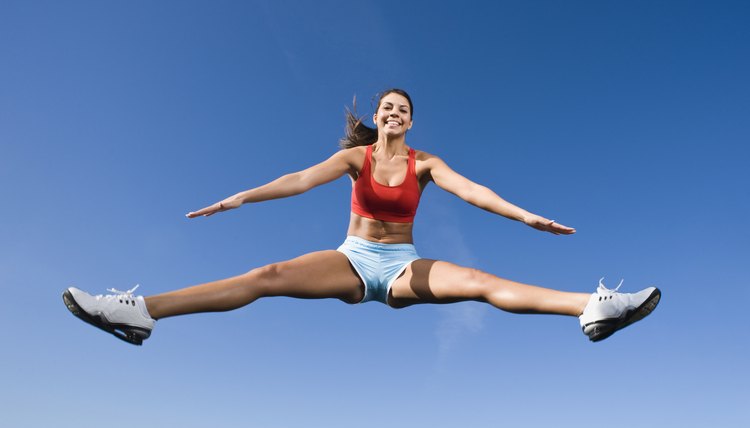What does fact checked mean?
At SportsRec, we strive to deliver objective content that is accurate and up-to-date. Our team periodically reviews articles in order to ensure content quality. The sources cited below consist of evidence from peer-reviewed journals, prominent medical organizations, academic associations, and government data.
The information contained on this site is for informational purposes only, and should not be used as a substitute for the advice of a professional health care provider. Please check with the appropriate physician regarding health questions and concerns. Although we strive to deliver accurate and up-to-date information, no guarantee to that effect is made.
What Exercises Do Competitive Cheerleaders Do?

A competitive cheerleading routine is just 2 1/2 minutes long, but cheerleaders must cheer, dance, jump, tumble and stunt the entire time. Because competitive cheerleading is a highly athletic activity that requires endurance, strength, flexibility and balance, training for it should include exercises that target all of these areas. Incorporate these exercises at every practice and perform them on off days in between practices as well.
Building Endurance
In order to perform for 2 1/2 minutes straight, competitive cheerleaders need endurance. Cardiovascular exercise is what will build endurance. A great way to train for endurance at practice is to perform three to five repetitions of your competition routine in sequence. Running is another cardiovascular activity that can easily be done by the entire squad at practice. Outside of practice, cheerleaders should be encouraged to participate in aerobic activities such as rollerblading, biking or aerobic dance classes. At least half of your daily training time should be devoted to increasing cardiovascular endurance.
Strength Training
Lifting other cheerleaders in stunts and holding your own body weight in tumbling requires a great deal of strength. When strength training as a squad, a good option is body weight exercises such as pushups and situps because they do not require any equipment to be shared by your entire squad. For independent training, lifting weights is a great option. Cheerleaders should be trained in proper form and should always lift weights with a spotting partner. Strength training should be done at least three days per week.
Stretching and Flexibility
The jumps, tumbling and stunting positions involved in cheerleading require extensive flexibility. Static or stationary stretching is the type of stretching that will help you improve your flexibility and it should be done daily. Do static stretches only after a thorough warmup. Include head-to-toe stretching of all of the major muscle groups in your body, but also focus on cheerleading-specific stretches such as straddles, splits and back bends. Hold all static stretches for 30 seconds and repeat each stretch three times.
Better Balance
Balance is important not just for the top person in stunts. Bases need good balance as well, and tumbling and jumps require steady balance too. Standing balance poses from yoga are a great way to balance-train. Put a cheerleading spin on your poses by making them mimic stunting positions. For example, instead of doing the Tree pose from yoga, turn it into a Liberty with your arms above your head in a high V motion. Incorporate at least one balance exercise into your training routine every day. Hold balance poses for 30 seconds or longer, breathing deeply throughout them. As you progress you may want to train on a balance cushion or pillow that will challenge your stability even more.
References
Writer Bio
Based in Wisconsin farm country, Jami Kastner has been writing professionally since 2009 and has had many articles published online. Kastner uses her experience as a former teacher, coach and fitness instructor as a starting point for her writing. She has a Bachelor of Arts degree in secondary education from Trinity International University.
